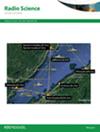Rectenna design optimized by binary genetic algorithm for hybrid energy harvesting applications across 5G sub-6 GHz band
IF 1.5
4区 地球科学
Q3 ASTRONOMY & ASTROPHYSICS
引用次数: 0
Abstract
This paper presents a novel rectenna design for hybrid energy harvesting, optimized using a binary genetic algorithm (BGA) with binary coding to improve geometry, impedance matching, and radiation efficiency. The fabricated rectenna achieves reflection coefficients below −40 dB at 2.45 and 5.8 GHz, demonstrating excellent impedance matching. A commercial rectifier (Powercast P21XXCSR-EVB), employing a voltage doubler topology and Schottky diodes (Skyworks SMS7630 and Avago HSMS 285B), is integrated for RF-to-DC conversion. Peak efficiencies of 90% at 2.45 GHz and 52% at 5.8 GHz are recorded at 11 dBm input power, while efficiencies above 80% and 50%, respectively, are maintained at 0 dBm. The rectifier also exhibits wide impedance bandwidths, with reflection coefficients of − 23 dB and −18 dB at the respective frequencies. Outdoor testing yields DC output voltages of 92.6 mV (2.45 GHz) and 64 mV (5.8 GHz). The system's efficiency and adaptability under variable conditions make it ideal for low-power applications such as wireless sensor networks, Internet of Things devices, and remote monitoring. Its robust performance across environments highlights its potential for autonomous energy harvesting in 5G and sub-6 GHz networks.采用二进制遗传算法优化的整流天线设计,用于5G sub- 6ghz频段的混合能量收集应用
本文提出了一种用于混合能量收集的新型整流天线设计,采用二进制编码的二进制遗传算法(BGA)进行优化,以改善几何形状,阻抗匹配和辐射效率。制作的整流天线在2.45 GHz和5.8 GHz时的反射系数低于- 40 dB,显示出良好的阻抗匹配。集成了商用整流器(Powercast P21XXCSR-EVB),采用倍压器拓扑和肖特基二极管(Skyworks SMS7630和Avago HSMS 285B),用于rf到dc转换。当输入功率为11dbm时,在2.45 GHz和5.8 GHz时的效率分别达到90%和52%的峰值,而在0dbm时,效率分别保持在80%和50%以上。整流器还显示出宽的阻抗带宽,在各自的频率下反射系数为- 23 dB和- 18 dB。室外测试的直流输出电压为92.6 mV (2.45 GHz)和64 mV (5.8 GHz)。该系统在各种条件下的效率和适应性使其成为无线传感器网络、物联网设备和远程监控等低功耗应用的理想选择。其在各种环境中的强大性能突出了其在5G和6ghz以下网络中自主能量收集的潜力。
本文章由计算机程序翻译,如有差异,请以英文原文为准。
求助全文
约1分钟内获得全文
求助全文
来源期刊

Radio Science
工程技术-地球化学与地球物理
CiteScore
3.30
自引率
12.50%
发文量
112
审稿时长
1 months
期刊介绍:
Radio Science (RDS) publishes original scientific contributions on radio-frequency electromagnetic-propagation and its applications. Contributions covering measurement, modelling, prediction and forecasting techniques pertinent to fields and waves - including antennas, signals and systems, the terrestrial and space environment and radio propagation problems in radio astronomy - are welcome. Contributions may address propagation through, interaction with, and remote sensing of structures, geophysical media, plasmas, and materials, as well as the application of radio frequency electromagnetic techniques to remote sensing of the Earth and other bodies in the solar system.
 求助内容:
求助内容: 应助结果提醒方式:
应助结果提醒方式:


